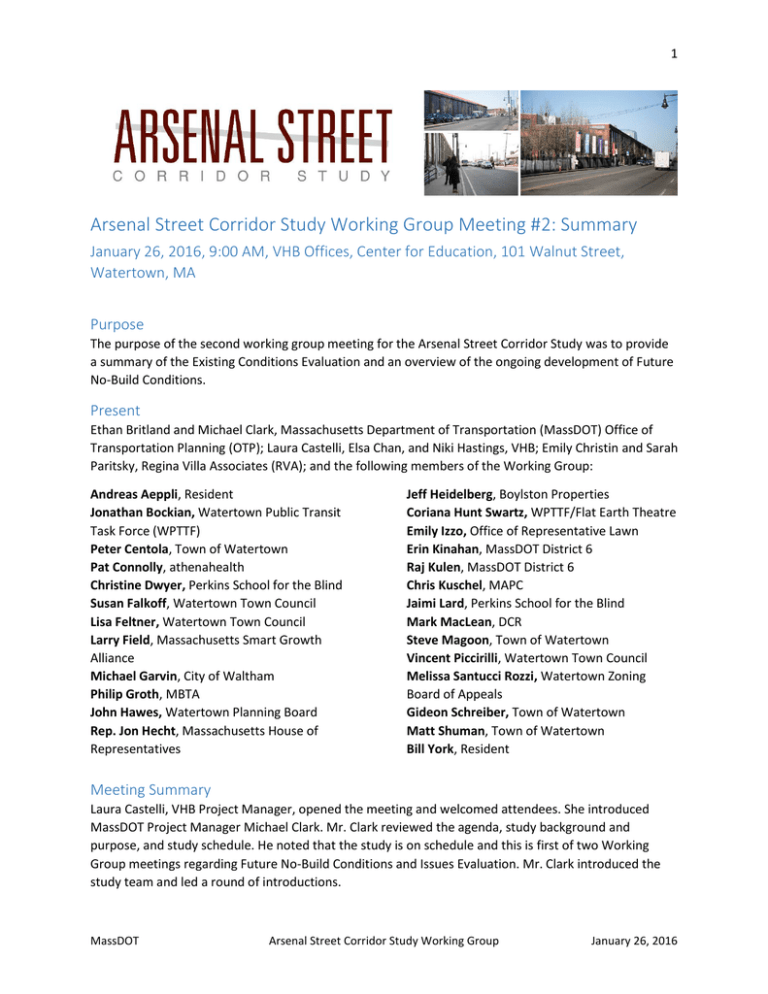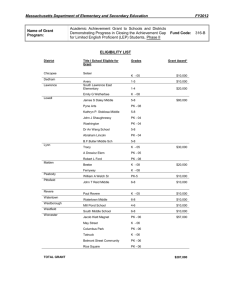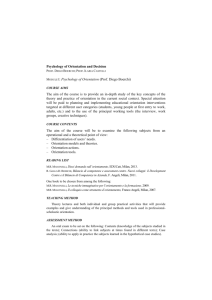Arsenal Street Corridor Study Working Group Meeting #2: Summary Watertown, MA Purpose
advertisement

1 Arsenal Street Corridor Study Working Group Meeting #2: Summary January 26, 2016, 9:00 AM, VHB Offices, Center for Education, 101 Walnut Street, Watertown, MA Purpose The purpose of the second working group meeting for the Arsenal Street Corridor Study was to provide a summary of the Existing Conditions Evaluation and an overview of the ongoing development of Future No-Build Conditions. Present Ethan Britland and Michael Clark, Massachusetts Department of Transportation (MassDOT) Office of Transportation Planning (OTP); Laura Castelli, Elsa Chan, and Niki Hastings, VHB; Emily Christin and Sarah Paritsky, Regina Villa Associates (RVA); and the following members of the Working Group: Andreas Aeppli, Resident Jonathan Bockian, Watertown Public Transit Task Force (WPTTF) Peter Centola, Town of Watertown Pat Connolly, athenahealth Christine Dwyer, Perkins School for the Blind Susan Falkoff, Watertown Town Council Lisa Feltner, Watertown Town Council Larry Field, Massachusetts Smart Growth Alliance Michael Garvin, City of Waltham Philip Groth, MBTA John Hawes, Watertown Planning Board Rep. Jon Hecht, Massachusetts House of Representatives Jeff Heidelberg, Boylston Properties Coriana Hunt Swartz, WPTTF/Flat Earth Theatre Emily Izzo, Office of Representative Lawn Erin Kinahan, MassDOT District 6 Raj Kulen, MassDOT District 6 Chris Kuschel, MAPC Jaimi Lard, Perkins School for the Blind Mark MacLean, DCR Steve Magoon, Town of Watertown Vincent Piccirilli, Watertown Town Council Melissa Santucci Rozzi, Watertown Zoning Board of Appeals Gideon Schreiber, Town of Watertown Matt Shuman, Town of Watertown Bill York, Resident Meeting Summary Laura Castelli, VHB Project Manager, opened the meeting and welcomed attendees. She introduced MassDOT Project Manager Michael Clark. Mr. Clark reviewed the agenda, study background and purpose, and study schedule. He noted that the study is on schedule and this is first of two Working Group meetings regarding Future No-Build Conditions and Issues Evaluation. Mr. Clark introduced the study team and led a round of introductions. MassDOT Arsenal Street Corridor Study Working Group January 26, 2016 2 Ms. Castelli presented the Existing Conditions Evaluation for transit. She showed a map of the existing bus routes in the study area, and a list of connections to Greater Boston that are provided by these bus routes. She noted that the study team will keep this in mind when developing alternatives. Ms. Castelli showed a table of service times and frequencies of bus Routes 70 and 70A. Route 70 operates twice as frequently as Route 70A. Comment: An attendee said there is a rumor that Route 70 has altered its route to accommodate new destinations like Market Basket. Philip Groth, MBTA, said that is true. Ms. Castelli summarized the condition of bus stops along the corridor, including nine inbound and ten outbound stops. She showed maps of the inbound and outbound stops with insets of photographs of each stop. The sidewalk clearance is generally adequate for the majority of the inbound stops. There are more obstructions at the outbound stops, such as utility poles. At one outbound stop, the project team observed people waiting for the bus in the middle of the bicycle path due to the presence of a construction fence blocking the waiting area. Ms. Castelli showed a map of the bus stops that have the highest numbers of daily boardings and alightings. The highest ridership stops are Watertown Yard, Watertown Square, Centre Street in Newton, and the Watertown and Arsenal Mall. This data may change as ongoing and proposed developments shape the corridor. Ms. Castelli reviewed the MBTA’s Service Delivery Policy, which defines the “acceptable levels of crowding by time period and transportation mode” for all of its services. She explained that Routes 70 and 70A bus service on Arsenal Street meet the Service Delivery Policy’s standards the majority of the time. A table of weekday maximum average passenger loads for Routes 70 and 70A shows that there are a few time periods in which not every passenger can have a seat. Ms. Castelli presented a graphic of the average vehicle loads on MBTA buses along Arsenal Street by segment for inbound and outbound service. For any load beyond 39 passengers, some passengers must stand. The average vehicle loads never exceed 54 (the MBTA service limit standard) during peak hours along the corridor. Ms. Castelli also presented a table of weekday average trip on-time performance by time period of Routes 70 and 70A along the corridor. Comment: Mr. Groth explained that as of now, buses that leave early, which is common for buses that operate in a loop, are considered “not on time.” He said the Service Delivery Policy may change to allow buses to leave up to one minute early. Question: Rep. Jon Hecht asked how the Route 70 and Route 70A service day averages compare to service overall in the MBTA. Mr. Groth and Ms. Castelli said that 70-75% average on-time performance is the goal, so Routes 70 and 70A are average compared to routes in surrounding communities. Comment: Susan Falkoff, Watertown Town Council, said that buses leaving early are worse than being late. Mr. Groth said that the MBTA would not implement a change to the Service Delivery Policy regarding the allowance of early departures without discussing changes with riders first. Comment: Jonathan Bockian, WPTTF, said that the averages do not show wait times. He said that the WPTTF is collecting better data that would be useful. Ms. Castelli noted that the project team is not just looking at quantitative data, but is also obtaining anecdotal data on the corridor. Comment: Mr. Groth offered to share granular data with the Working Group. MassDOT Arsenal Street Corridor Study Working Group January 26, 2016 3 Question: Rep. Hecht asked how the project team is considering impacts of new transit options in their projections. Ms. Castelli said the project team is looking at Central Transportation Planning Staff’s (CTPS’s) Transit Forecast in 2040, regional traffic studies and developer information, and demographic data. The team will make assumptions based on current transit use and population data to predict any increase in transit use. Question: Larry Field, MA Smart Growth Alliance, asked if the project team is just going to use aggregated data. Ms. Castelli explained that the team is taking a holistic look at the corridor and will compare their observations with the sources of data mentioned. Ms. Castelli presented the Existing Conditions Evaluation for traffic and safety. She showed a map of the 20 intersections along the study corridor from which the data was collected. The team observed vehicles avoiding an intersection on Arsenal Street by taking Taylor Street. She summarized the findings from the signal inventory taken from 14 signalized intersections along the corridor and issues were noted at all locations. The team will release a list of short-term recommendations to resolve these issues. Ms. Castelli explained that the project team reviewed MassDOT statewide crash data and the District 6 Average Crash Rate (ACR). She showed a map of the top crash locations along the corridor. One of the state’s top 200 crash intersections is in the study corridor (Galen Street/Nonantum Road/Watertown Street). There are several crash clusters within the corridor that are Highway Safety Improvement Program (HSIP) eligible, such as the unsafe pedestrian crossing in the Watertown Square area. Ms. Castelli noted that the most recent MassDOT crash data is from 2011-2013, but newer crash data from other sources (Watertown Police Department) is similar. She summarized the locations within the study corridor that exceed the District 6 ACR, and the majority of crashes appear not to be caused by speed or weather. Ms. Castelli presented the traffic count data observed by project staff on the corridor and traffic cameras. She showed maps of turning movements and traffic volumes during AM and PM peak hours, and a table of daily traffic counts. Watertown Square has the highest traffic volumes. Ms. Castelli explained that the project team uses a VISSIM model to analyze traffic patterns. VISSIM is a simulation computer software that can track delays and show the interaction between vehicles, bicycles, and pedestrians. Ms. Castelli reviewed the Measures of Effectiveness (MOE) for evaluating traffic. The two main MOE are delays and queues, which are not always related. Ms. Castelli showed a map of intersection operations along the corridor. Birmingham Parkway and Watertown Square are the most congested areas in the corridor with the lowest Level of Service (LOS). She provided images of sample average traffic queues in Watertown Square and Birmingham Parkway. Question: Steve Magoon, Town of Watertown asked how cut-through traffic is measured for traffic volume data. Ms. Castelli said that there is no quantifiable data for cut-through traffic, but the project team will consider the routes that drivers are taking to avoid segments of Arsenal Street (such as using School Street, Taylor Street, Louise Street, and Beechwood Avenue) during the alternatives development. Ms. Castelli said the team’s goal is not to discourage drivers from doing this, but rather to encourage them not to and to take Arsenal Street instead. Comment: Peter Centola, Town of Watertown, said that there are many intersections with a “no turn on red” restriction that are unnecessary. Ms. Castelli thanked him for his comments. MassDOT Arsenal Street Corridor Study Working Group January 26, 2016 4 Question: Mr. Bockian asked if it is too late for the team to include Greenough Boulevard and North Beacon Street in the study. Ms. Castelli said yes, it is too late, but the team will be able to observe traffic on these streets at a qualitative level. Ms. Castelli presented the Existing Conditions Evaluation for bicycles and pedestrians. Most of the sidewalks in the corridor are in good condition, with some areas of deficiencies. Wheelchair ramps were inventoried along the corridor. There are many ramps that can be made ADA compliant with short-term fixes. Ms. Castelli showed a map of bicycle paths and lanes on and near the study corridor. She also showed turning movement and traffic volume data for bicycles and pedestrians during morning and evening peak hours. Question: A participant asked what percentage of the total traffic volume data included bicycles and pedestrians. Ms. Castelli and Ms. Chan were not certain, but estimated a very low percentage, probably 1% for bicycles and 2-3% for pedestrians. Most bike and pedestrian traffic is crossing the study area. Question: Rep. Hecht asked if bicycle and pedestrian numbers include those who use the community path. Ms. Castelli said no, but the team could place a counter on the path. Question: Rep. Hecht asked if the crash data include accidents involving pedestrians and bicyclists. Ms. Castelli said yes. Any accident involving a vehicle reported to the police or the Registry of Motor Vehicles is included in the data. Pedestrian/bicycle crashes are often not included if they did not involve personal injury. Comment: Mr. Magoon commented that the volume of pedestrian and bike traffic is so low because there is not much incentive for them on the corridor. The team could consider creating more opportunities for them in the alternatives development. Ms. Castelli agreed and noted that the residential and commercial development along the corridor may change these numbers as well. Ms. Castelli reviewed ongoing improvements to bicycle and pedestrian accommodations, such as the Greenough Boulevard Riverfront Park Restoration and the Watertown Community Path. Ms. Castelli presented the Existing Conditions Evaluation for the socioeconomics and demographics of the corridor. She reviewed population and employment data, the top locations where Watertown residents travel to work, and locations from where Watertown employees are traveling. Ms. Castelli noted that current trends indicate there will continue to be a shift in employment from manufacturing and industrial jobs to office, research & development, and service jobs. Ms. Castelli showed pie charts of the transportation modes used by Watertown residents and workers. The vast majority drive alone to work. Ms. Castelli showed a map of the current land use in the study area, which shows the boundaries for the population data used by the project team. Ms. Castelli reviewed the limited environmental resources and constraints along the corridor, and stated that none are expected to have a significant effect on the alternatives development. Question: Mr. Bockian asked if demographics of the corridor, including age, have an effect on the study. Ms. Castelli said yes, and explained that age tends to influence transit use. Ms. Castelli summarized the available public health data. The data available is being used to create a baseline health profile that will be considered during alternatives development, with the goal of MassDOT Arsenal Street Corridor Study Working Group January 26, 2016 5 improving public health. She reviewed the various public health barriers facing the study area residents based on the existing built environments. Ms. Castelli presented the data sources that are used in the 2040 Future Conditions report, and the development projects on and near the corridor that are being considered. She explained that the next Working Group meeting will focus more on the 2040 Future Conditions. Ms. Castelli reviewed the Next Steps for the project, and noted the upcoming public meeting to be scheduled in February. The next Working Group meeting will be in early spring. Question & Answer Session Comment: Gideon Schreiber, Town of Watertown, suggested adding the residential development on the corridor to the Development Projects map and slide. Ms. Castelli thanked him for his comment. Question: Andreas Aeppli asked if the study is looking at the potential for future development. Ms. Castelli said that RKG is taking a broad look at the corridor in its land use/economic analysis and will include what could happen in the future, but VHB is focused on what is already slated to happen. Question: A participant asked if the study has the capacity for different future conditions scenarios. Ms. Castelli said there will only be one 2040 land use condition analysis. Comment: Mr. Field said that study should definitely develop different scenarios for future conditions. Ms. Castelli said the team will be cautious and assume more will happen rather than less. VHB will take land use and zoning information into consideration. Mr. Heidelberg stated that Boylston Properties has data that he could share with Ms. Castelli. Question: Ms. Falkoff asked what happens after the implementation of short-term recommendations, and who is accountable for implementing them. Ms. Castelli said the project will continue with alternatives analysis. Short-term recommendations can be implemented more quickly. Ms. Castelli believes the Town of Watertown would be accountable. Mr. Magoon said the Town will have these conversations with MassDOT in the near future. Question: Mr. Magoon asked if the study is considering technology changes, such as self-driving cars. Ms. Castelli said yes, the alternatives development will consider possible effects of technology changes. Most of the alternatives will be focus on improvements to transit, bicycles, and pedestrians. The roadway capacity on Arsenal Street is limited, so expanding the road will probably not be viable. Question: Mr. Bockian asked if the study is considering the impact on Arsenal Street if the Arsenal Street Bridge were to undergo reconstruction. Ms. Castelli said she has not heard of any plans to reconstruct the bridge, but if that were to happen it would primarily be a traffic management challenge, and would likely not change the capacity of the bridge. Question: Rep. Hecht said the Arsenal Street Bridge is a nightmare for bicycles and pedestrians, and asked if there would be a future analysis for the Western Avenue side of the bridge. Ms. Castelli said the study team is aware of the poor bike and pedestrian conditions on the bridge. The study will be in touch with all surrounding communities to share current development plans, but will not ask each community what might happen in the future. She noted a representative of the Town of Waltham is present. MassDOT Arsenal Street Corridor Study Working Group January 26, 2016 6 Comment: Rep. Hecht suggested that the study invite Harvard and the City of Cambridge to be involved in the study. Ms. Castelli thanked him for his comment. Question: Melissa Santucci Rozzi, Watertown Zoning Board of Appeals, asked if there is background growth data available. Ms. Castelli said the study team is taking a very realistic look at growth, which is why they are using three different sources. Question: Ms. Izzo asked if the study is considering eliminating some of the stops on Route 70 and 70A. Ms. Castelli said stop consolidation and traffic signal reconfiguration will be explored more thoroughly during alternatives development. Mr. Groth and Ms. Castelli explained that accessibility is an impediment to removing or consolidating stops. Comment: Christine Dwyer and Jami Lard, Perkins School for the Blind, commented that there are drainage problems by the Arsenal Mall bus stop that are impeding accessibility to wheelchairs. Ms. Castelli thanked them for the comment, and said the study team has shared their findings from the wheelchair ramp inventory with the Town of Watertown on what needs to be fixed. Question: A participant asked why 75% is the MBTA standard for on-time service. Ms. Castelli explained this is to account for unpredictability. Mr. Groth stated that this standard is measured differently for buses and rapid transit. Vincent Piccirilli, Watertown Town Council, commented that the MBTA should change their metrics and measure what the average customer would want from its service in order to enact changes in mode choice. Question: An attendee asked what will be covered at the first public meeting. Ms. Castelli said the presentation will cover a high level existing conditions report. The team will ask the participants to decide what is important to them. Question: Ms. Santucci-Rozzi asked if there is historic data the study can use to observe a change in different modes. Ms. Castelli said there is not much data available regarding bicycle and pedestrian growth that is older than what the team is currently using. Comment: Mr. Field suggested that the team present counts of boardings and alightings along Arsenal Street at the public meeting. Ms. Castelli thanked him for his comment. Ms. Castelli and Mr. Clark thanked the Working Group for attending and concluded the meeting. MassDOT Arsenal Street Corridor Study Working Group January 26, 2016





